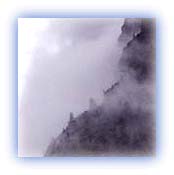Sikkim himalayas
· Kanchendzonga
· The Teesta Saga
· Zemu Glacier
· Northern Sikkim
Flora and Fauna
People
· Lanchenpas & Lanchungpas
Religion
Visual Delights

![]()
| General info Sikkim, a state lying in the northeastern part of India, is one of the more physically accessible sections of the Himalaya. Within four days from Calcutta in the Indian state of West Bengal, the traveler can be among some of the loftiest mountains in the world. In the olden days, this region was known as Basyul -- the hidden land. Sikkim forms part of the Eastern Himalayas which, among other features, is known for the heavy rain it receives compared with the western Himalayas. |
 |
| Hillsides shrouded in mist Credit: Karamjeet Singh |
Sikkim is surrounded by Nepal to the west, Tibet (China) to the north, Bhutan to the west and the Indian state of West Bengal to the south. It has considerable importance due to its strategic location. While in the early years and even till about the middle of the 20th century Sikkim remained a favorite among trekkers, explorers and mountaineers on short holidays, from the 1950s the region began to come under geographical restrictions.
The restrictions mainly affected foreigners. But gradually, with developments like the deterioration of Indo-Chinese relations, the flight of the Dalai Lama, and the Indo-Sikkimese Treaty by which the defence of Sikkim fell to India, permission even to Indian nationals became restricted in certain areas, especially around the border passes into Tibet. Visitors to the area and mountaineering expeditions had to spend considerable amounts of time to obtain permits beyond the Inner Line, and mountaineering activity in the region became restricted to teams from the Indian Armed Forces. Around 1961, all but the small area of Western Sikkim was closed to everyone except army personnel.
Only since the late 1970s have restrictions been relaxed slightly and have trekkers and mountaineering expeditions been allowed in the region.
All rights reserved